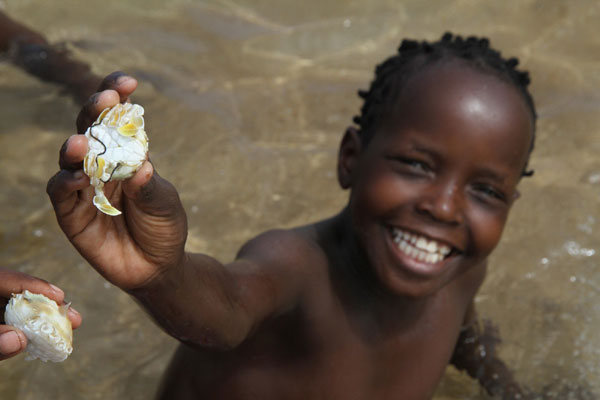Resort life on the cheap
 |
|
A child holds up a crab in the water near the community of Conguiana in Mozambique.[Photo by Seth Kugel/Agencies] |
Voluntary guide
There are two ways to make the excursion - either as a trip organized by outfitters in Tofo or solo, arming yourself with a good guidebook and map. I opted for neither, arriving with no plan and no idea where anything was - which gave me no right at all to have a good time.
But I got lucky, eventually finding my way to the public library, where, past a display of the history of Mozambican postage stamps, I met Dorte Eduardo Gueze, a young man in a "Government of Inhambane" polo shirt.
I asked what there was to see in town, and without any ado he told me to follow him out the back door of the library, past a statue of Vasco da Gama and a rusted old car that he said was the first to ever reach Inhambane. Then he proceeded to lead me around town for something like three hours. Gueze wasn't looking for money and had no idea I was writing an article - he just thought it sounded like a fun thing to do.
It was. We ambled from one landmark to another, including a variety of religious venues - a crumbling, colonial-era Catholic church, two very attractive whitewashed mosques, the Hindu "church", as he called it - as well as a cultural center, where we admired a room of locally produced art, and the old cinema, still in use.
Particularly striking were the ruins of waterfront buildings where slaves were held before being shipped out - the walls were crumbling but the bars in the windows and the locks on the gates were still holding fast. Somewhere else, this would be a museum. I had to force him to take some money for his time.
I spent a total of $275 on my four-day, three-night Tofo trip, and it proved a good mix of relaxed beach time, marmalade and shrimp consumption, history and exploration. But the way back was even better. My original goal had been to reach Barra, the community at the tip of the peninsula, and take a chapa back to Tofo. But after the children told me they lived over the dunes, I walked another half-mile or so up the peninsula, tempted to try to cut across to the road that led back down its spine. On the map it looked to be less than a mile away.














